LC-MS/MS-QTOF Identification of Phenolic Compounds of Sideritis Species Cultivated in Greece
Abstract
:1. Introduction
2. Materials and Methods
2.1. Chemicals and Reagents
2.2. Plant Material
2.3. Preparation of Extracts
2.4. LC-MS/MS-QTOF
2.5. Identification of Phenolic Compounds and Statistical Analysis of LC-MS/MS-QTOF Data
3. Results and Discussion
4. Conclusions
Author Contributions
Funding
Data Availability Statement
Conflicts of Interest
References
- Lattanzio, V. Natural Products. Phenolic Compounds: Introduction; Springer: Berlin/Heidelberg, Germany, 2013; pp. 1543–1580. [Google Scholar] [CrossRef]
- Manousi, N.; Sarakatsianos, I.; Samanidou, V. 10—Extraction techniques of phenolic compounds and other bioactive compounds from medicinal and aromatic plants. In Engineering Tools in the Beverage Industry; Grumezescu, A.M., Holban, A.M., Eds.; Woodhead Publishing: Sawston, UK, 2019; pp. 283–314. [Google Scholar] [CrossRef]
- Kisiriko, M.; Anastasiadi, M.; Terry, L.A.; Yasri, A.; Beale, M.H.; Ward, J.L. Phenolics from Medicinal and Aromatic Plants: Characterisation and Potential as Biostimulants and Bioprotectants. Molecules 2021, 26, 6343. [Google Scholar] [CrossRef] [PubMed]
- Lattanzio, V.; Lattanzio, V.M.T.; Cardinali, A. Role of phenolics in the resistance mechanisms of plants against fungal pathogens and insects. In Phytochemistry: Advances in Research; Imperato, F., Ed.; Research Signpost: Kerala, India, 2006; Volume 661, pp. 23–67. [Google Scholar]
- Tsimogiannis, D.; Oreopoulou, V. Classification of phenolic compounds in Plants. In Polyphenols in Plants Isolation Purification and Extract Preparation, 2nd ed.; Watson, R.R., Ed.; Elsevier Inc.: London, UK, 2019; pp. 263–284. [Google Scholar]
- Costa, D.; Costa, H.; Albuquuerque, T.; Ramos, F.; Castilho, M.; Sanches-Silva, A. Advances in phenolic compounds analysis of aromatic plants and their potential applications. Trends Food Sci. Technol. 2015, 45, 336–354. [Google Scholar] [CrossRef]
- Tungmunnithum, D.; Thongboonyou, A.; Pholboon, A.; Yangsabai, A. Flavonoids and Other Phenolic Compounds from Medicinal Plants for Pharmaceutical and Medical Aspects: An Overview. Medicine 2018, 5, 93. [Google Scholar] [CrossRef] [PubMed]
- Trivellini, A.; Lucchesini, M.; Maggini, R.; Mosadegh, H.; Villamarin, T.S.S.; Vernieri, P.; Mensuali-Sodi, A.; Pardossi, A. Lamiaceae phenols as multifacetedcompounds: Bioactivity, industrial prospects and role of positive-stress. Ind. Crops Prod. 2016, 83, 241–254. [Google Scholar] [CrossRef]
- Aghakhani, F.; Kharazian, N.; Gooini, Z.L. Flavonoid Constituents of Phlomis (Lamiaceae) Species Using Liquid Chromatography Mass Spectrometry. Phytochem. Anal. 2017, 29, 180–195. [Google Scholar] [CrossRef] [PubMed]
- Milevskaya, V.V.; Temerdashev, Z.A.; Butyl’Skaya, T.S.; Kiseleva, N.V. Determination of phenolic compounds in medicinal plants from the Lamiaceae family. J. Anal. Chem. 2017, 72, 342–348. [Google Scholar] [CrossRef]
- Hossain, M.B.; Rai, D.K.; Brunton, N.P.; Martin-Diana, A.B.; Barry-Ryan, C. Characterization of phenolic composition in lamiaceae spices by lc-esi-ms/ms. J. Agric. Food Chem. 2010, 58, 10576–10581. [Google Scholar] [CrossRef] [PubMed]
- Vladimir-Knežević, S.; Blažeković, B.; Kindl, M.; Vladić, J.; Lower-Nedza, A.D.; Brantner, A.H. Acetylcholinesterase Inhibitory, Antioxidant and Phytochemical Properties of Selected Medicinal Plants of the Lamiaceae Family. Molecules 2014, 19, 767–782. [Google Scholar] [CrossRef] [PubMed]
- Panda, S.K.; Van Puyvelde, L.; Mukazayire, M.J.; Gazim, Z.C. Editorial: Ethnopharmacology of the lamiaceae: Opportunities and challenges for developing new medicines. Front. Pharmacol. 2022, 13, 961486. [Google Scholar] [CrossRef] [PubMed]
- Skendi, A.; Irakli, M.; Chatzopoulou, P. Analysis of phenolic compounds in Greek plants of Lamiaceae family by HPLC. J. Appl. Res. Med. Aromat. Plants. 2017, 6, 62–69. [Google Scholar] [CrossRef]
- Stanoeva, J.P.; Stefova, M.; Stefkov, G.; Kulevanova, S.; Alipieva, K.; Bankova, V.; Ina Aneva, I.; Evstatieva, L.N. Chemotaxonomic contribution to the Sideritis species dilemma on the Balkans. Biochem. Syst. Ecol. 2015, 61, 477–487. [Google Scholar] [CrossRef]
- Kaparakou, E.H.; Daferera, D.; Kanakis, C.D.; Skotti, E.; Kokotou, M.G.; Tarantilis, P.A. Chemical composition of the essential oils of three popular Sideritis species cultivated in Greece using GC-MS analysis. Biomolecules 2023, 13, 1157. [Google Scholar] [CrossRef] [PubMed]
- Panossian, A. Herba Sideritis: A putative adaptogen for reducing the risk of age-related cognitive decline and neurodegenerative disorders. Phytomedicine Plus 2024, 4, 100519. [Google Scholar] [CrossRef]
- Bojovic, D.; Jankovic, S.; Potpara, Z.; Tadic, V. Summary of the phytochemical research performed to date on Sideritis species. Ser. J. Exp. Clin. Res. 2011, 12, 109–122. [Google Scholar] [CrossRef]
- Heywood, V.H. Flora Europaea: Notulae Systematicae ad Floram Europaeam spectantes: No. 12. Bot. J. Linn. Soc. 1972, 65, 223–269. [Google Scholar] [CrossRef]
- Hayek, A.V. Prodromus Florae peninsulae Balcanicae2, 192–197. Feddes Repert. Sp. Nov. Beih. 1929, 30. [Google Scholar]
- Fraga, B.M. Phytochemistry and chemotaxonomy of Sideritis species from the Mediterranean region. Phytochemistry 2012, 76, 7–24. [Google Scholar] [CrossRef] [PubMed]
- González-Burgos, E.; Carretero, M.E.; Gòmez-Serranillos, M.P. Sideritis spp.: Uses, chemical composition and pharmacological activities—A review. J. Ethnopharmacol. 2011, 135, 209–225. [Google Scholar] [CrossRef]
- Axiotis, E.; Petrakis, E.A.; Halabalaki, M.; Mitakou, S. Phytochemical Profile and Biological Activity of Endemic Sideritis sipylea Boiss. in North Aegean Greek Islands. Molecules 2020, 25, 2022. [Google Scholar] [CrossRef]
- Di Giacomo, S.; Di Sotto, A.; Angelis, A.; Percaccio, E.; Vitalone, A.; Gullì, M.; Macone, A.; Axiotis, E.; Skaltsounis, A.L. Phytochemical Composition and Cytoprotective Properties of the Endemic Sideritis sipylea Boiss Greek Species: A Valorization Study. Pharmaceuticals 2022, 15, 987. [Google Scholar] [CrossRef]
- Żyżelewicz, D.; Kulbat-Warycha, K.; Oracz, J.; Żyżelewicz, K. Polyphenols and other bioactive compound s of Sideritis plants and their potential biological activity. Molecules 2020, 25, 3763. [Google Scholar] [CrossRef] [PubMed]
- Tadić, V.; Oliva, A.; Božović, M.; Cipolla, A.; De Angelis, M.; Vullo, V.; Garzoli, S.; Ragno, R. Chemical and Antimicrobial Analyses of Sideritis romana L. subsp. purpurea (Tal. ex Benth.) Heywood, an Endemic of the Western Balkan. Molecules 2017, 22, 1395. [Google Scholar] [PubMed]
- Aligiannis, N.; Kalpoutzakis, E.; Chinou, I.; Mitakou, S.; Gikas, E.; Tsarbopoulos, A. Composition and antimicrobial activity of the essential oils of five taxa of Sideritis from Greece. J. Agric. Food Chem. 2001, 49, 811–815. [Google Scholar] [CrossRef] [PubMed]
- EMA/HMPC/39455/2015. Assessment report on Sideritis scardica Griseb.; Sideritis clandestina (Bory & Chaub.) Hayek; Sideritis raeseri Boiss. & Heldr.; Sideritis syriaca L., herba. (2016). Committee on Herbal Medicinal Products (HMPC). Available online: https://www.ema.europa.eu/en/documents/herbal-report/final-assessment-report-sideritis-scardica-griseb-sideritis-clandestina-bory-chaub-hayek-sideritis_en.pdf (accessed on 12 July 2023).
- Dimaki, V.D.; Zeliou, K.; Nakka, F.; Stavreli, M.; Bakratsas, I.; Papaioannou, L.; Iatrou, G.; Lamari, F.N. Characterization of Sideritis clandestina subsp. peloponnesiaca Polar Glycosides and Phytochemical Comparison to Other Mountain Tea Populations. Molecules 2022, 27, 7613. [Google Scholar] [CrossRef]
- Mróz, M.; Malinowska-Pańczyk, E.; Bartoszek, A.; Kusznierewicz, B. Comparative Study on Assisted Solvent Extraction Techniques for the Extraction of Biologically Active Compounds from Sideritis raeseri and Sideritis scardica. Molecules 2023, 28, 4207. [Google Scholar] [CrossRef]
- Zheleva-Dimitrova, D.; Voynikov, Y.; Gevrenova, R.; Balabanova, V. A Comprehensive Phytochemical Analysis of Sideritis scardica Infusion Using Orbitrap UHPLC-HRMS. Molecules 2024, 29, 204. [Google Scholar] [CrossRef] [PubMed]
- Petreska, J.; Stefkov, G.; Kulevanova, S.; Alipieva, K.; Bankova, V.; Stefova, M. Phenolic Compounds of Mountain Tea from the Balkans: LC/DAD/ESI/MSn Profile and Content. Nat. Prod. Commun. 2011, 6, 21–30. [Google Scholar] [CrossRef] [PubMed]
- Guvenc, A.; Okada, Y.; Akkol, E.K.; Duman, H.; Okuyama, T.; Calış, İ. Investigations of anti-inflammatory, antinociceptive, antioxidant and aldose reductase inhibitory activities of phenolic compounds from Sideritis brevibracteata. Food Chem. 2010, 118, 686–692. [Google Scholar] [CrossRef]
- Tian, X.Y.; Li, M.; Lin, T.; Qiu, Y.; Zhu, Y.T.; Li, X.L.; Tao, W.D.; Wang, P.; Ren, X.X.; Chen, L.P. A Review on the Structure and Pharmacological Activity of Phenylethanoid Glycosides. Eur. J. Med. Chem. 2021, 209, 112563. [Google Scholar] [CrossRef]
- Naveed, M.; Hejazi, V.; Abbas, M.; Kamboh, A.A.; Khan, G.J.; Shumzaid, M.; Ahmad, F.; Babazadeh, D.; Xia, F.; Modarresi-Ghazani, F. Chlorogenic acid (CGA): A pharmacological review and call for further research. Biomed. Pharmacother. 2018, 97, 67–74. [Google Scholar] [CrossRef]
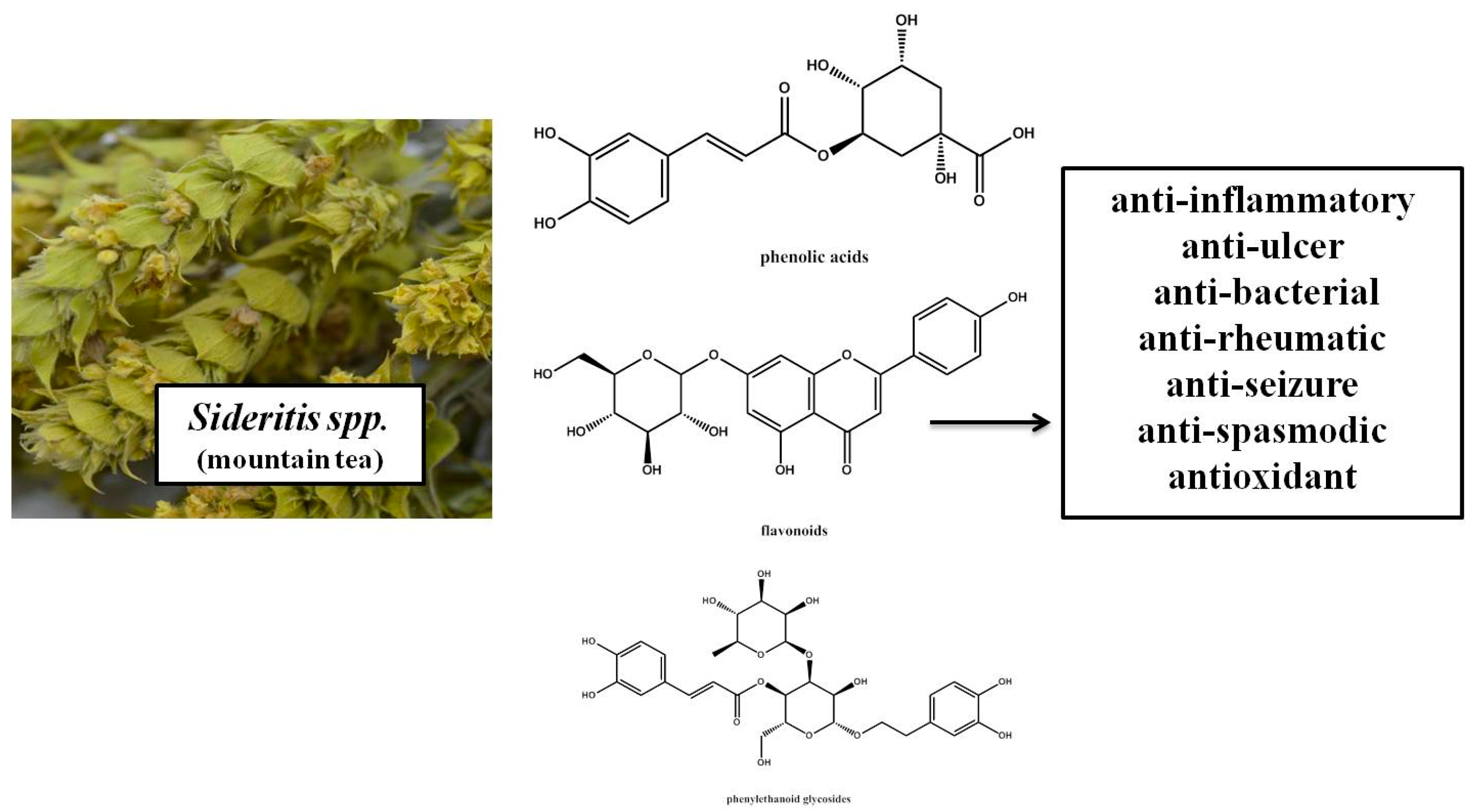


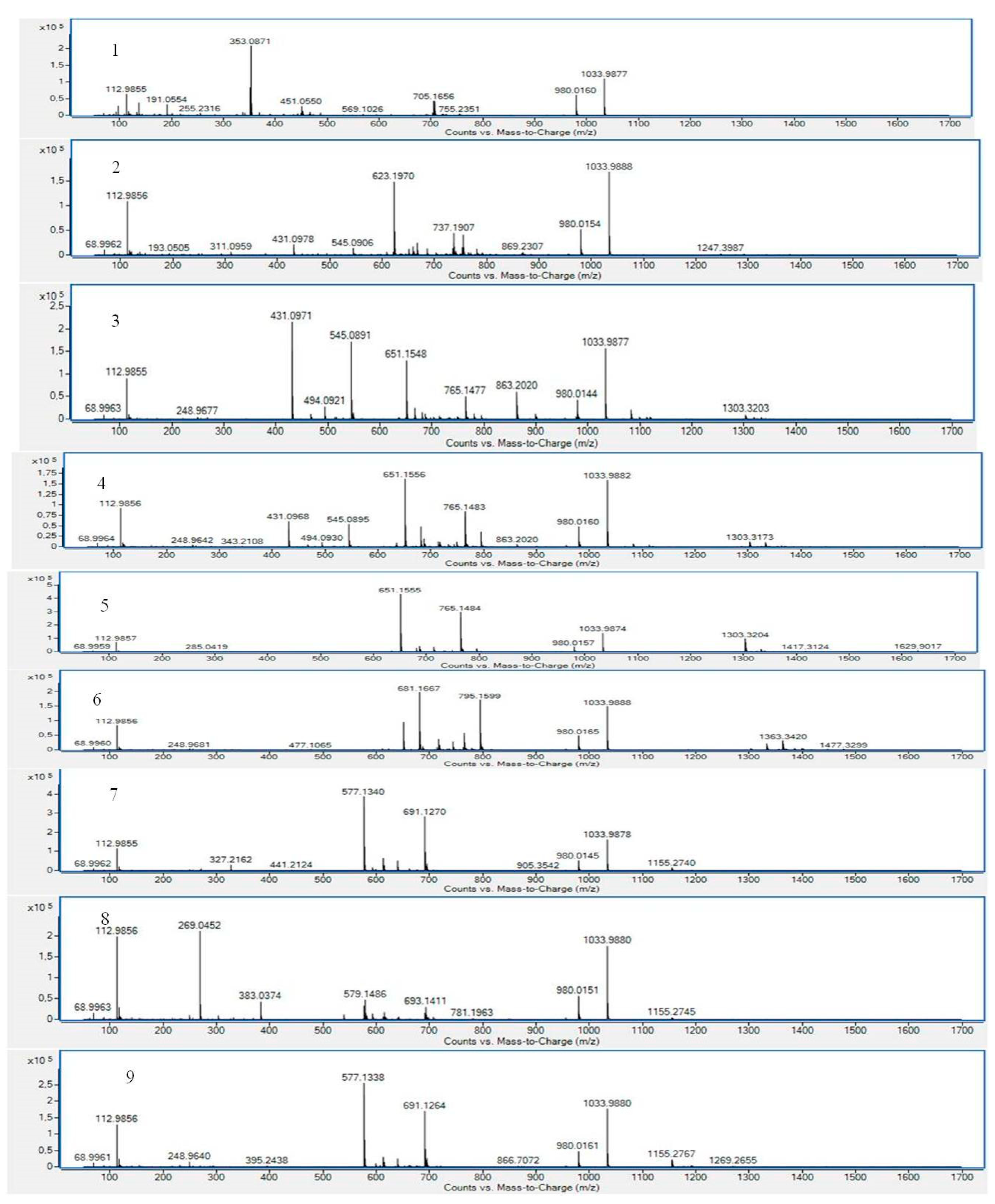

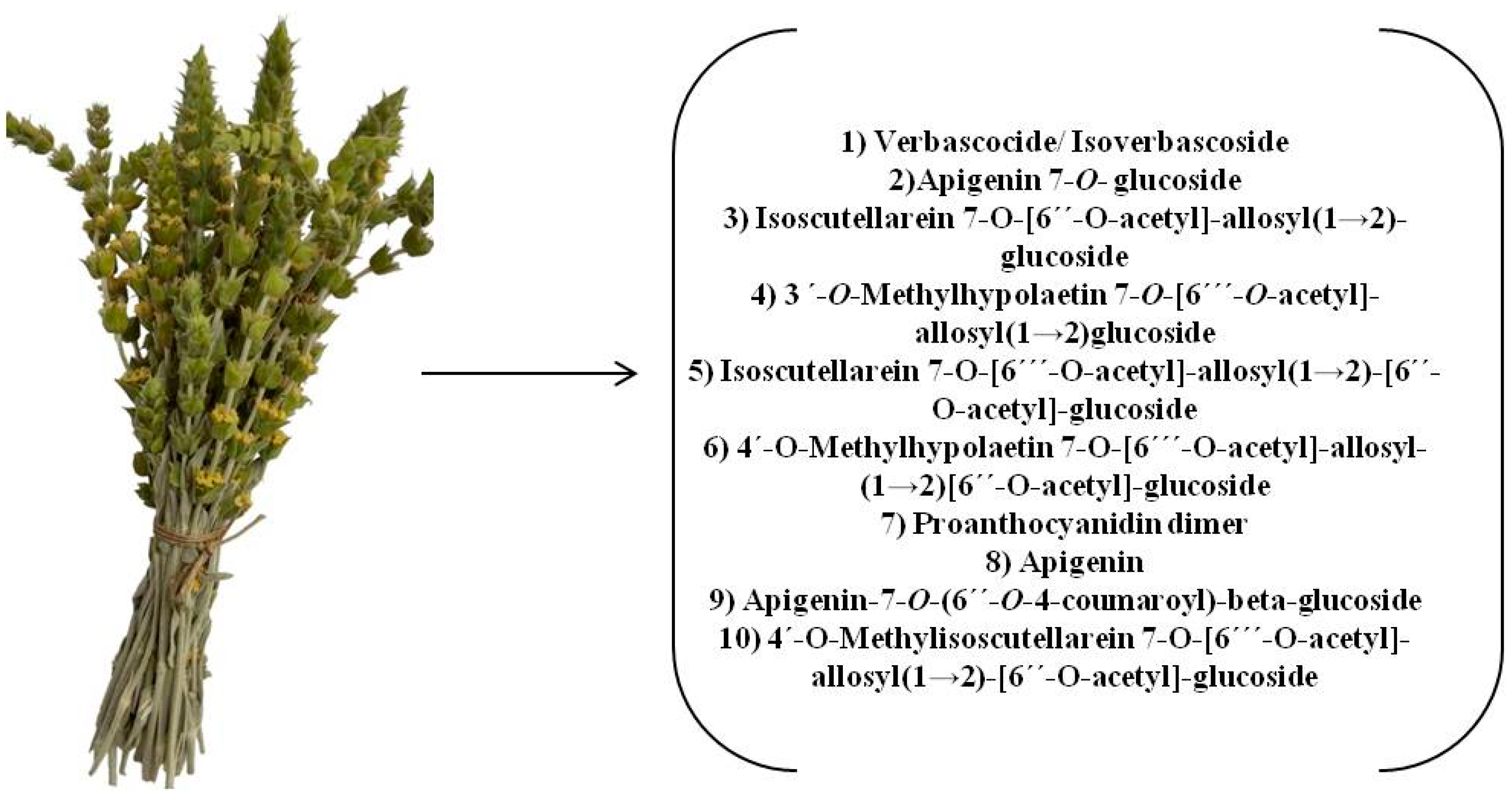

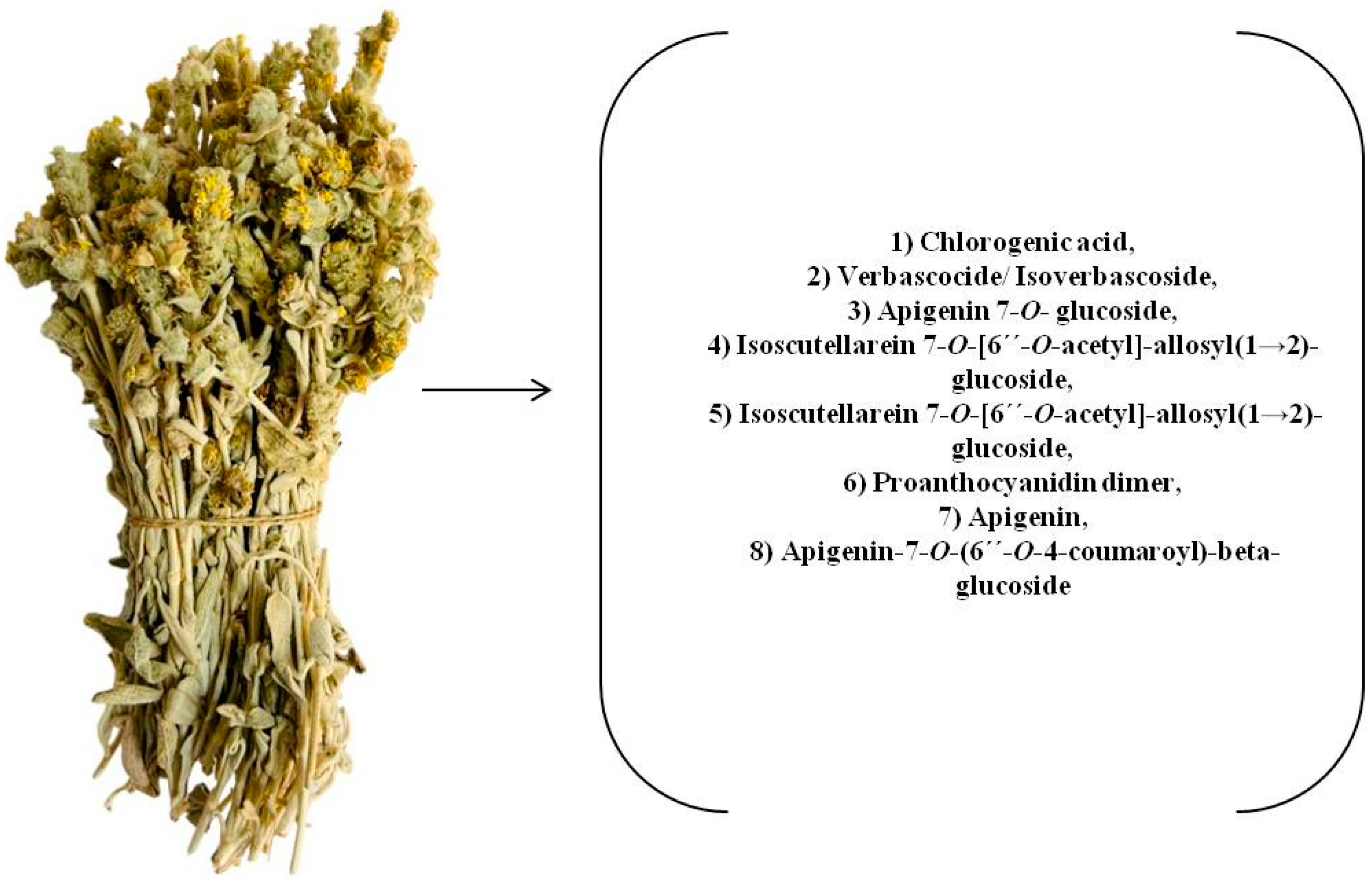
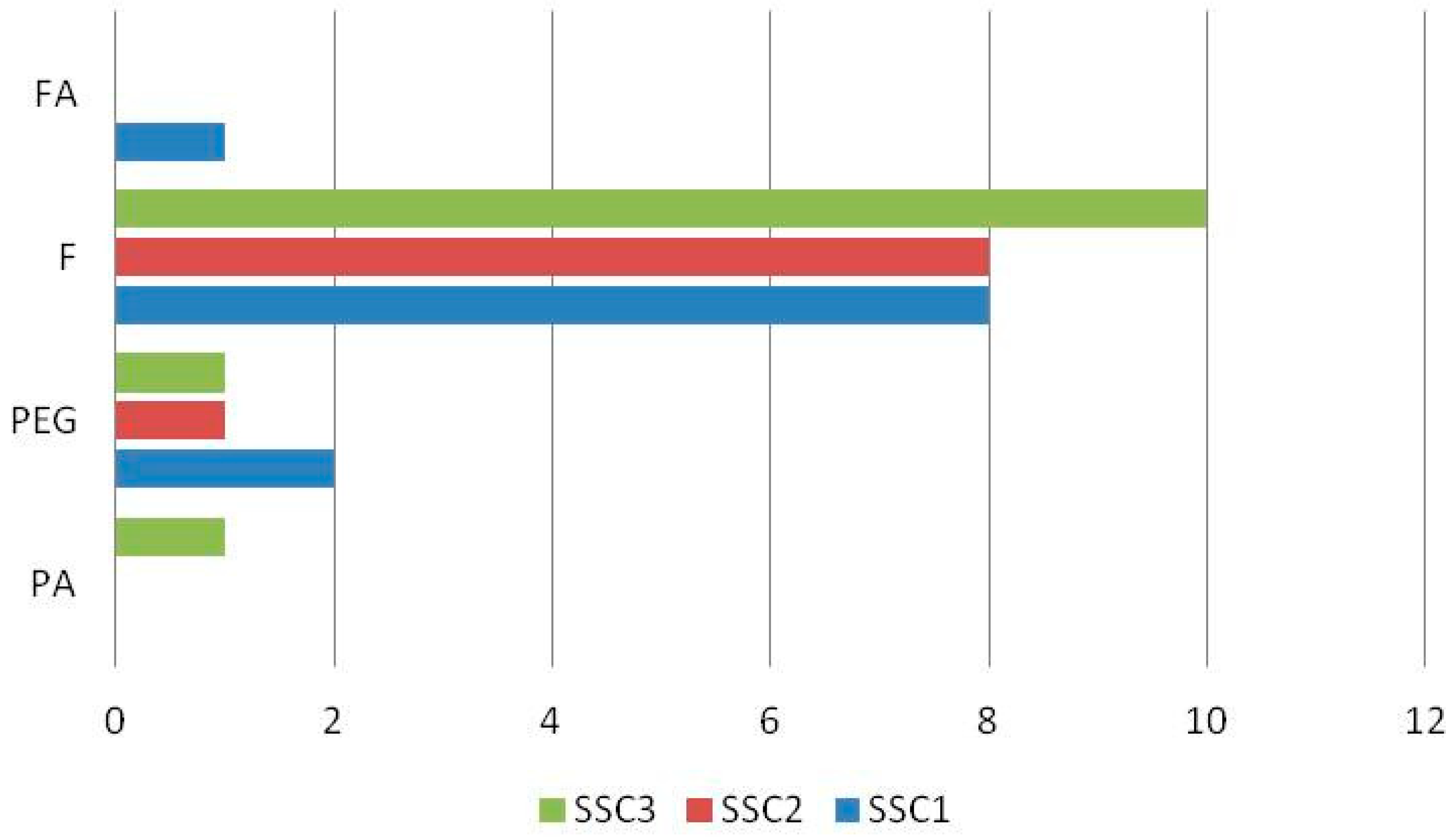

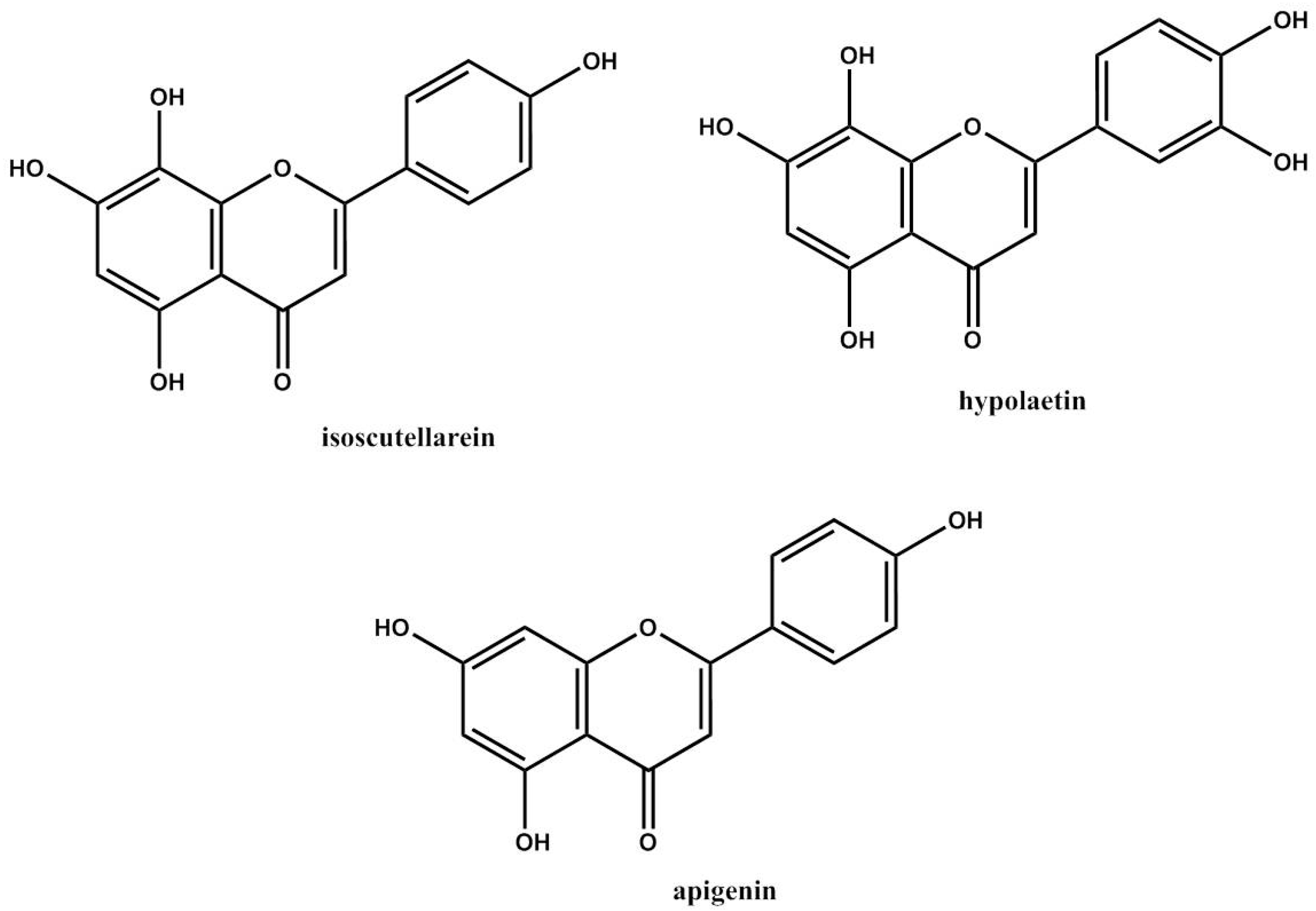
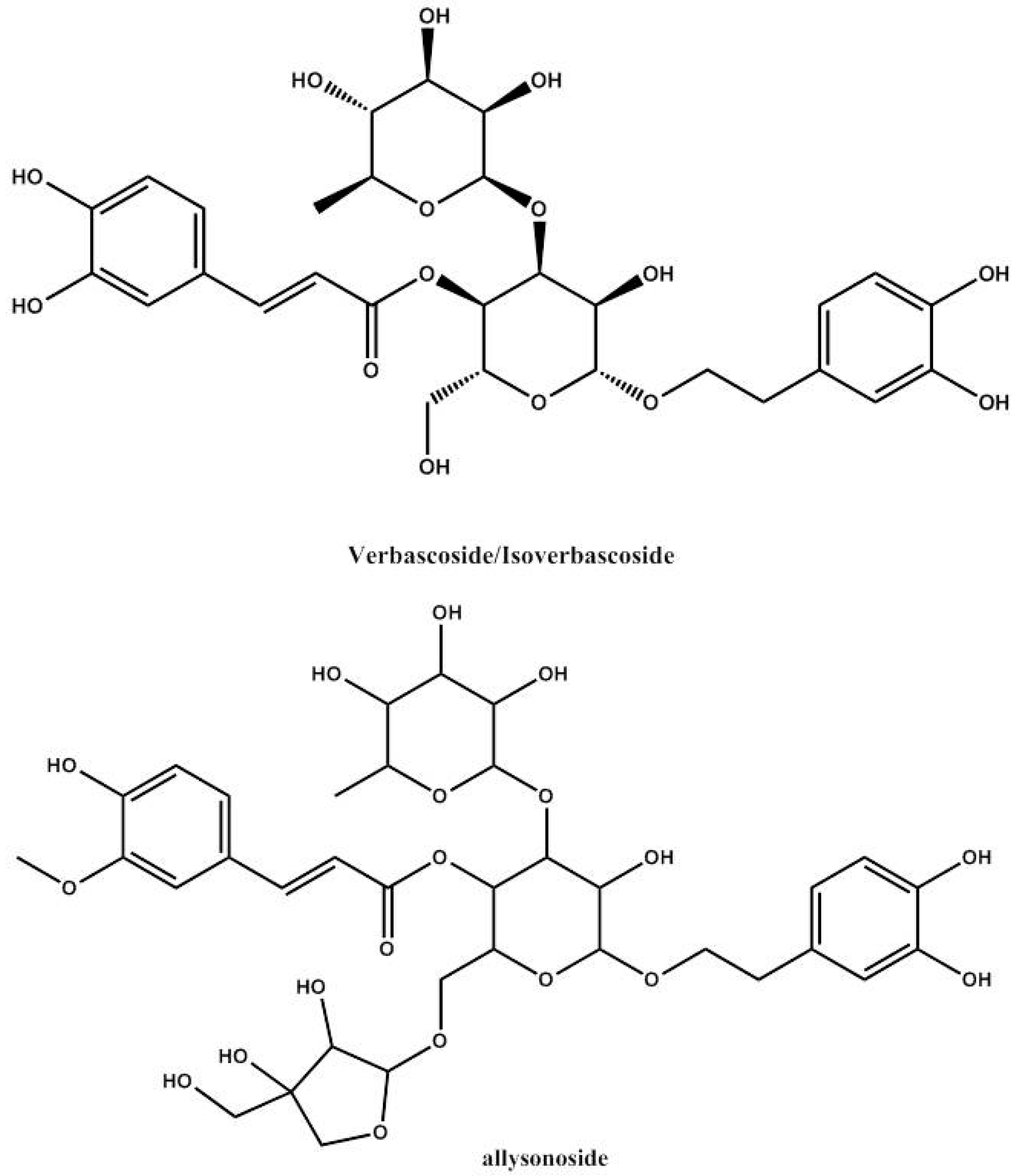
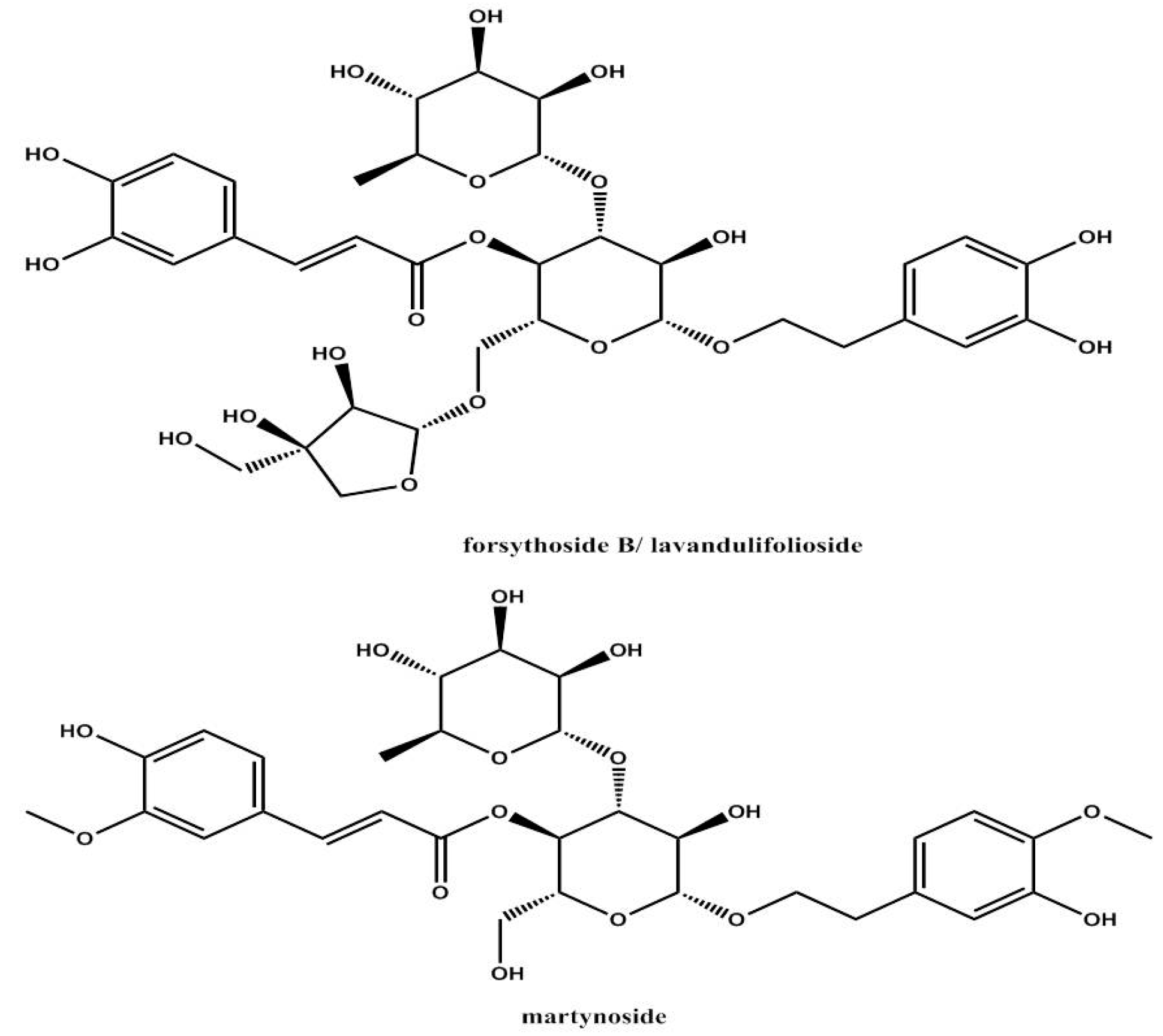
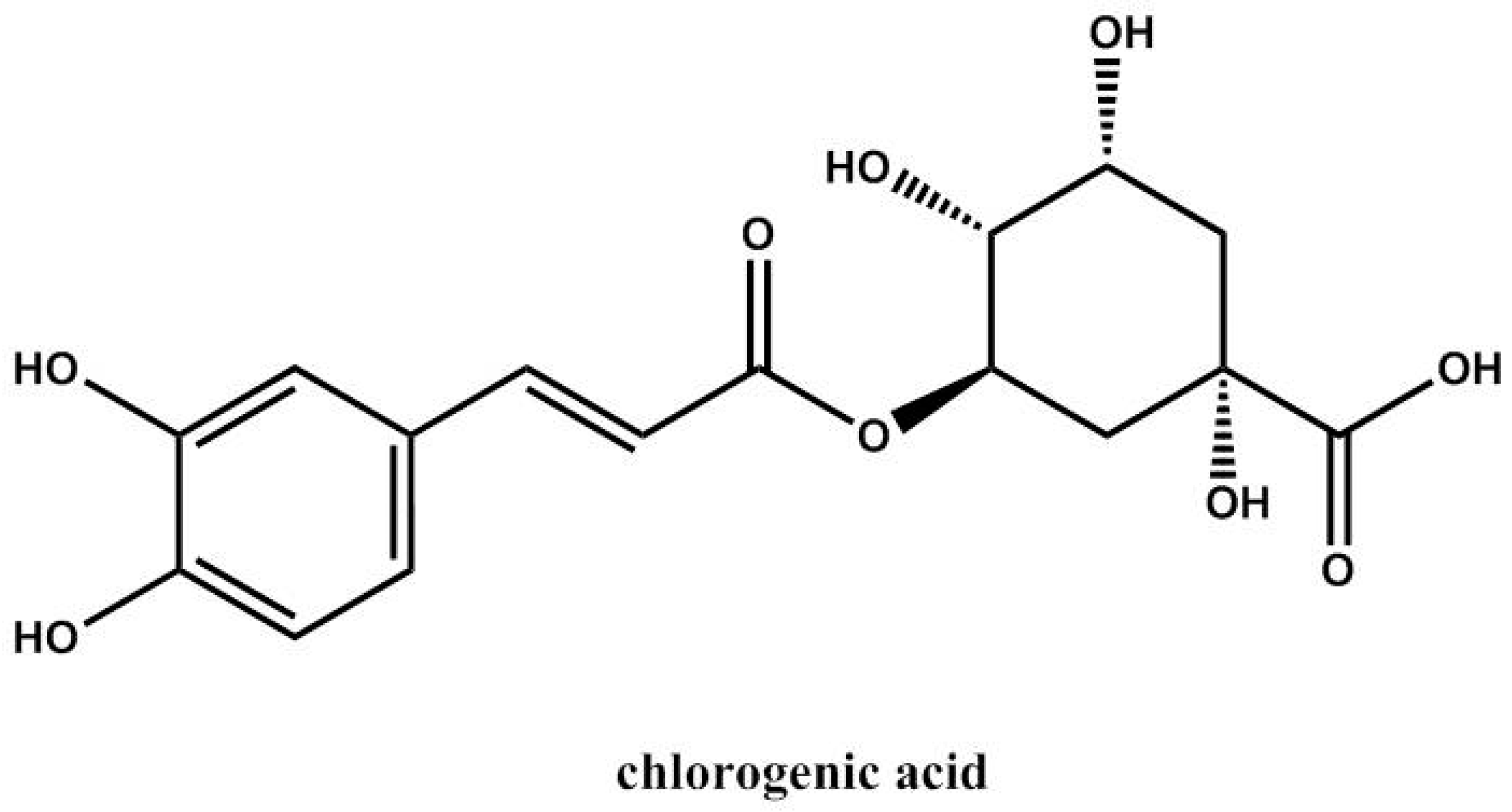

| No. | Compound | Retention Time (min) | Suggested Formula | Exact Mass [M−H]− | Fragmentation Pattern in (−) ESI-MS/MS | S. raeseri | S. scardica | S. syriaca | Ref. | ||||||
|---|---|---|---|---|---|---|---|---|---|---|---|---|---|---|---|
| SR1 a | SR2 | SR3 | SSC1 | SSC2 | SSC3 | SS1 | SS2 | SS3 | |||||||
| 1 | Chlorogenic acid | 3.154 | C16H18O9 | 353.0871 | 191.0506 | + b | - c | - | - | - | + | + | + | + | [29,30,31] std |
| 2 | Forsythoside B/Lavandulifolioside | 5.755 | C34H44O19 | 755.2390 | 161.0227 | - | + | - | - | - | - | - | - | - | [15,25,29,30,31,32] |
| 3 | Verbascocide/Isoverbascoside | 5.959 | C29H36O15 | 623.1970 | 161.0238 | + | + | + | + | + | + | + | + | + | [15,25,29,30,31,32] std |
| 4 | Allysonoside | 6.803 | C35H46O19 | 769.2544 | 175.0392 | - | + | - | - | - | - | - | - | - | [15,25,29,30,31,32] |
| 5 | Hypolaetin 7-O-[6‴-O-acetyl]-allosyl(1→2)-glucoside | 7.039 | C29H32O18 | 667.1507 | 301.0341 | - | + | - | - | - | - | - | - | - | [15,25,29,30,31,32] |
| 6 | Apigenin 7-O-glucoside | 7.336 | C21H20O10 | 431.0971 | 268.0393 | + | + | + | + | + | + | + | + | + | [15,25,30,31,32] |
| 7 | Isoscutellarein 7-O-[6′-O-acetyl]-allosyl(1→2)-glucoside | 7.412 | C29H32O17 | 651.1556 | 285.0396 | + | - | + | + | + | + | + | + | + | [15,25,29,30,31,32] |
| 8 | 4′-O-Methylhypolaetin7-O-[6‴-O-acetyl]-allosyl(1→2)glucoside | 7.749 | C30H34O18 | 681.1660 | 315.0510 | + | + | - | + | + | - | - | - | - | [15,29,30,31,32] |
| 9 | Isoscutellarein 7-O-[6″-O-acetyl]-allosyl(1→2)-glucoside | 7.994 | C29H32O17 | 651.1555 | 285.0394 | + | + | + | + | + | + | + | + | + | [15,25,29,30,31,32] |
| 10 | 3′-O-Methylhypolaetin 7-O-[6‴--O-acetyl]-allosyl(1→2)glucoside | 8.289 | C30H34O18 | 681.1667 | 315.0485 | + | + | + | + | + | + | - | + | + | [15,25,29,30,32] |
| 11 | Martynoside | 8.533 | C31H40O15 | 651.1971 | 175.0419 | - | - | - | + | - | - | - | - | - | [25,30,31] |
| 12 | 4′-O-Methylisoscutellarein 7-O-allosyl(1→2)glucoside | 8.662 | C28H32O16 | 623.1608 | 299.0553 | + | - | + | - | - | - | - | - | + | [15,25,30,31,32] |
| 13 | Hypolaetin 7-O-[2‴,6″-di-O-acetyl]-allosyl(1→2)glucoside | 9.405 | C31H34O19 | 709.1619 | 301.0307 | - | + | - | - | - | - | - | - | - | [15,29,30,32] |
| 14 | 4′-O-Methylisoscutellarein 7-O-[6″-O-acetyl]-allosyl(1→2)-glucoside | 10.085 | C30H34O17 | 665.1718 | 299.0554 | + | - | + | + | + | + | - | - | + | [15,25,29,30,31,32] |
| 15 | Isoscutellarein 7-O-[6‴-O-acetyl]-allosyl(1→2)-[6″-O-acetyl]-glucoside | 10.386 | C31H34O18 | 693.1659 | 285.0398 | + | + | + | - | + | + | + | - | + | [25,29,30,31,32] |
| 16 | 4′-O-Methylhypolaetin 7-O-[6‴-O-acetyl]-allosyl-(1→2)[6″-O-acetyl]-glucoside | 10.622 | C32H36O19 | 723.1772 | 315.0518 | + | + | + | - | - | - | - | - | - | [15,25,29,30,31,32] |
| 17 | Proanthocyanidin dimer | 10.926 | C30H26O12 | 577.1340 | 269.0453 | + | + | + | - | - | - | + | + | + | [30] |
| 18 | Apigenin | 11.469 | C15H10O5 | 269.0452 | 151.0030 | + | + | + | - | - | + | + | + | + | std |
| 19 | Trihydroxy octadecenoic acid | 11.884 | C18H34O5 | 329.2327 | 211.1346 | - | - | - | + | - | - | - | - | - | [30,31] |
| 20 | Apigenin-7-O-(6″-O-4-coumaroyl)-beta-glucoside | 11.997 | C30H26O12 | 577.1338 | 269.0442 | + | + | + | + | + | + | + | + | + | [15,25,30,31,32] |
| 21 | 4′-O-Methylisoscutellarein 7-O-[6‴-O-acetyl]-allosyl(1→2)-[6″-O-acetyl]-glucoside | 12.412 | C32H36O18 | 707.1821 | 299.0553 | + | + | + | - | - | - | + | - | + | [15,25,30,31,32] |
| 22 | Cirsimaritin | 13.559 | C17H14O6 | 313.0714 | 283.0251 | + | - | + | - | - | + | + | - | + | [30] |
| 23 | Usnicacid/Eupatorin | 14.509 | C18H16O7 | 343.0816 | 313.0350 | + | - | + | + | - | + | + | - | + | [30] |
| Compound | Structure | Activity | Ref. |
|---|---|---|---|
| Verbascoside/ Isoverbascoside |  | anti-inflammatory activity prevention of red blood cell from free radical damage tyrosinase and/or melanin production inhibition activity | [22,23,25] |
| Apigenin-7-O-glucoside | 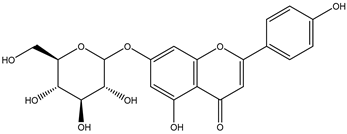 | antioxidant activity anti-inflammatory effect cytotoxicity to cancer cells promoting apoptosis of cancer cells anxiolytic effect memory improvement neuroprotective effect protective effect against amyloid-β-neurotoxicity | [25,26] |
| Isoscutellarein 7-O-[6″-O-acetyl]-allosyl(1→2)-glucoside | 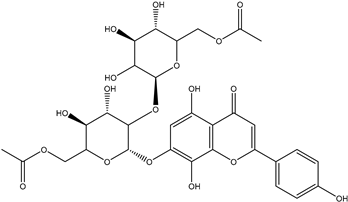 | moderate-to-weak cytotoxicity to cancer cells | [25] |
| Apigenin-7-O-(6″-O-4-cou-maroyl)-beta-glucoside |  | antioxidant activity anti-inflammatory effect cytotoxicity to cancer cells promoting apoptosis of cancer cells anxiolytic effect memory improvement neuroprotective effect protective effect against amyloid-β-neurotoxicity | [25,26] |
Disclaimer/Publisher’s Note: The statements, opinions and data contained in all publications are solely those of the individual author(s) and contributor(s) and not of MDPI and/or the editor(s). MDPI and/or the editor(s) disclaim responsibility for any injury to people or property resulting from any ideas, methods, instructions or products referred to in the content. |
© 2024 by the authors. Licensee MDPI, Basel, Switzerland. This article is an open access article distributed under the terms and conditions of the Creative Commons Attribution (CC BY) license (https://creativecommons.org/licenses/by/4.0/).
Share and Cite
Kaparakou, E.H.; Kanakis, C.D.; Kokotou, M.G.; Papadopoulos, G.; Tarantilis, P.A. LC-MS/MS-QTOF Identification of Phenolic Compounds of Sideritis Species Cultivated in Greece. Separations 2024, 11, 229. https://doi.org/10.3390/separations11080229
Kaparakou EH, Kanakis CD, Kokotou MG, Papadopoulos G, Tarantilis PA. LC-MS/MS-QTOF Identification of Phenolic Compounds of Sideritis Species Cultivated in Greece. Separations. 2024; 11(8):229. https://doi.org/10.3390/separations11080229
Chicago/Turabian StyleKaparakou, Eleftheria H., Charalabos D. Kanakis, Maroula G. Kokotou, Georgios Papadopoulos, and Petros A. Tarantilis. 2024. "LC-MS/MS-QTOF Identification of Phenolic Compounds of Sideritis Species Cultivated in Greece" Separations 11, no. 8: 229. https://doi.org/10.3390/separations11080229








